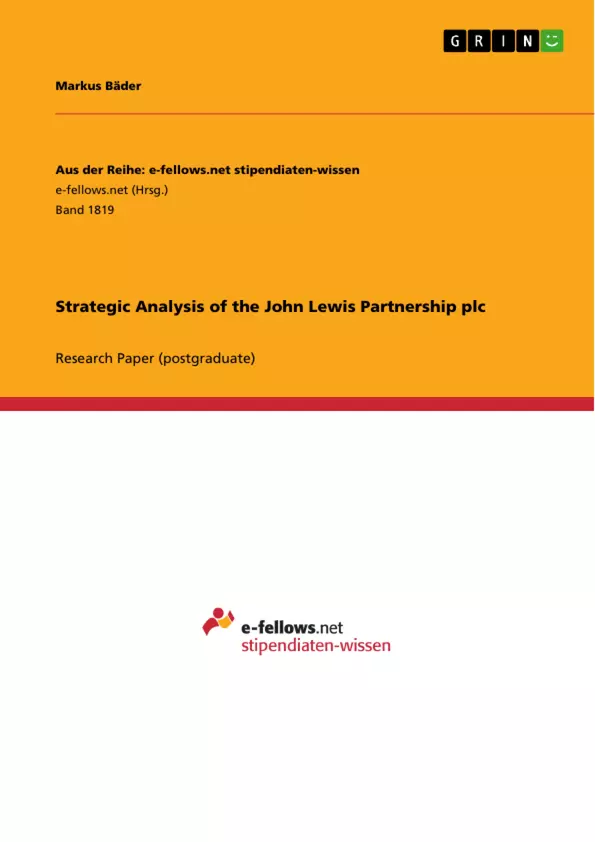London-based John Lewis Partnership plc (JLP or ‘the company’) is a leading UK retail chain, operating through the business divisions Waitrose and John Lewis. JLP’s retail services cover a wide range of products, including clothing, furniture and home technology on the department store side and upmarket food on the grocery side. Whereas most competing supermarkets, such as Tesco, and traditional department stores, such as Debenhams, are stock-listed companies, JLP is owned by its 93,800 employees who
operate 43 John Lewis, respectively 337 Waitrose stores dominantly in the UK.
Table of Contents
- Introduction
- Performance Evaluation
- Success Factors
- Strategic Capabilities
- Value Chain
- Primary Activities
- Supporting Activities
- VRIN Framework
- Value Chain
- Leadership
- Internationalisation
- Drivers and Strategy
- Market Entry
- Future Outlook
Objectives and Key Themes
This strategic analysis aims to evaluate the John Lewis Partnership plc's (JLP) performance, identify key success factors, and examine its strategic capabilities. The analysis considers JLP's position within the competitive UK retail market, exploring its growth strategies and future prospects.
- Performance Evaluation: Analyzing JLP's financial performance and stakeholder perceptions.
- Strategic Capabilities: Examining JLP's value chain and competitive advantages.
- Internationalization Strategies: Assessing JLP's approach to international expansion.
- Leadership and Employee Ownership: Exploring the impact of JLP's unique employee ownership model.
- Competitive Landscape: Analyzing JLP's position relative to its competitors.
Chapter Summaries
Introduction: This chapter introduces the John Lewis Partnership plc (JLP), a leading UK retail chain operating through Waitrose (grocery) and John Lewis (department stores). Unlike most competitors, JLP is employee-owned, a key differentiator impacting its strategic decisions and overall culture. The introduction establishes the context for the subsequent analysis of JLP's performance, strategies, and competitive position within the dynamic UK retail landscape.
Performance Evaluation: This chapter evaluates JLP's performance using both financial and non-financial metrics. While JLP demonstrates steady revenue growth and expansion in store numbers, its profit margins remain comparatively low compared to competitors. The analysis highlights the impact of competitive pricing pressures, particularly on the Waitrose grocery segment, despite overall growth across its retail operations. This underscores the challenges JLP faces in balancing expansion with profitability in a fiercely competitive market.
Strategic Capabilities: This section delves into JLP’s strategic capabilities, analyzing its value chain and applying the VRIN framework. The value chain analysis dissects primary and supporting activities, pinpointing key areas of strength and potential improvement. The VRIN framework assesses the value, rarity, imitability, and non-substitutability of JLP's resources and capabilities, identifying its competitive advantages and vulnerabilities. This detailed analysis aims to understand the sources of JLP’s competitive advantage and areas that may require strategic attention.
Leadership: [This chapter summary would go here if the provided text contained sufficient information on this topic. Since it does not, this section remains empty.]
Internationalisation: This chapter examines JLP's internationalization strategies, focusing on the drivers and market entry approaches. It likely analyzes the rationale behind international expansion and the specific methods employed by JLP to establish a presence in new markets. This detailed assessment evaluates the effectiveness and potential of JLP’s global ambitions, within the broader context of its overall strategic goals.
Keywords
John Lewis Partnership plc, Waitrose, John Lewis, UK retail, competitive advantage, employee ownership, value chain, VRIN framework, internationalization, market entry, strategic analysis, financial performance, profitability, market share, expansion, competitive landscape.
John Lewis Partnership plc Strategic Analysis: Frequently Asked Questions
What is this document?
This document is a comprehensive preview of a strategic analysis of the John Lewis Partnership plc (JLP), a leading UK retail chain. It includes a table of contents, objectives and key themes, chapter summaries, and keywords. The analysis focuses on JLP's performance, success factors, strategic capabilities, leadership, internationalization, and future outlook.
What are the key themes explored in the analysis?
The analysis explores several key themes, including JLP's financial performance and stakeholder perceptions; its strategic capabilities, including its value chain and competitive advantages; its internationalization strategies and market entry approaches; the impact of its unique employee ownership model on leadership and operations; and its competitive position within the UK retail market.
How is JLP's performance evaluated?
JLP's performance is evaluated using both financial and non-financial metrics. While the company demonstrates steady revenue growth and expansion, its profit margins are comparatively low compared to competitors. The analysis highlights the challenges JLP faces in balancing expansion with profitability in a competitive market, particularly within the Waitrose grocery segment.
What are JLP's strategic capabilities?
JLP's strategic capabilities are analyzed using a value chain analysis and the VRIN framework. The value chain analysis identifies key areas of strength and potential improvement within both primary and supporting activities. The VRIN framework assesses the value, rarity, imitability, and non-substitutability of JLP's resources and capabilities, helping to identify its competitive advantages and vulnerabilities.
What is the role of employee ownership in JLP's strategy?
The analysis highlights the unique employee ownership model of JLP as a key differentiator, impacting its strategic decisions and overall culture. The impact of this model on leadership and organizational performance is a significant area of focus in the study (though details are not fully presented in this preview).
What about JLP's internationalization strategies?
The analysis examines JLP's internationalization strategies, focusing on the drivers and market entry approaches used to establish a presence in new markets. It assesses the effectiveness and potential of JLP’s global ambitions in relation to its overall strategic goals.
What are the main chapters covered in the analysis?
The analysis includes chapters on Introduction, Performance Evaluation, Strategic Capabilities (including Value Chain and VRIN Framework analysis), Leadership, Internationalization, and Future Outlook.
What keywords are associated with this analysis?
Keywords include: John Lewis Partnership plc, Waitrose, John Lewis, UK retail, competitive advantage, employee ownership, value chain, VRIN framework, internationalization, market entry, strategic analysis, financial performance, profitability, market share, expansion, competitive landscape.
- Citar trabajo
- Markus Bäder (Autor), 2015, Strategic Analysis of the John Lewis Partnership plc, Múnich, GRIN Verlag, https://www.grin.com/document/323356



